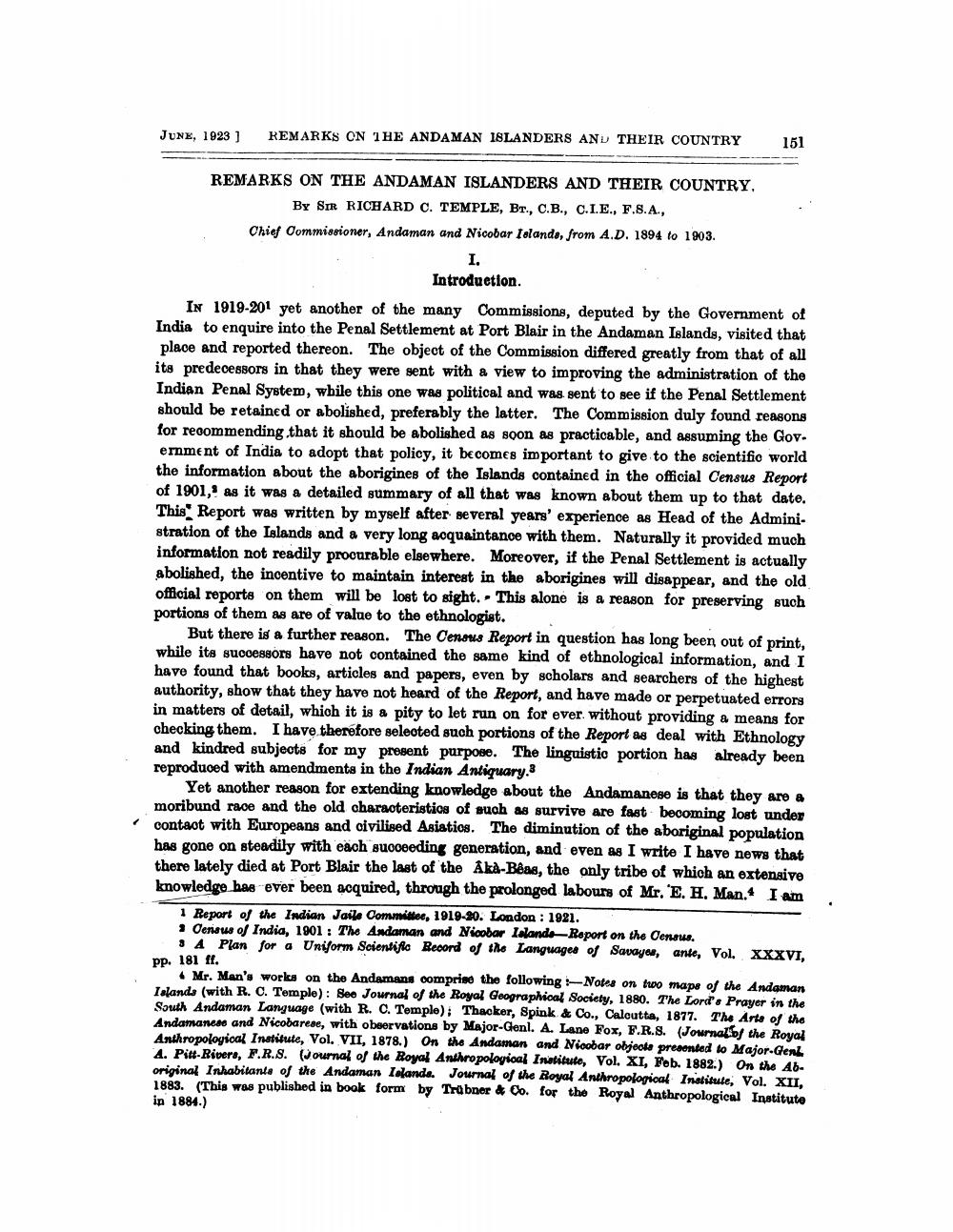________________
JUNE, 1923 ] REMARKS ON 1HE ANDAMAN 18LANDERS AND THEIR COUNTRY
REMARKS ON THE ANDAMAN ISLANDERS AND THEIR COUNTRY. BY SIR RICHARD C. TEMPLE, BT., C.B., C.I.E., F.S.A., Chief Commissioner, Andaman and Nicobar Islands, from A.D. 1894 to 1903.
I. Introduction.
151
IN 1919-201 yet another of the many Commissions, deputed by the Government of India to enquire into the Penal Settlement at Port Blair in the Andaman Islands, visited that place and reported thereon. The object of the Commission differed greatly from that of all its predecessors in that they were sent with a view to improving the administration of the Indian Penal System, while this one was political and was sent to see if the Penal Settlement should be retained or abolished, preferably the latter. The Commission duly found reasons for recommending that it should be abolished as soon as practicable, and assuming the Gov. ernment of India to adopt that policy, it becomes important to give to the scientific world the information about the aborigines of the Islands contained in the official Census Report of 1901, as it was a detailed summary of all that was known about them up to that date. This Report was written by myself after several years' experience as Head of the Administration of the Islands and a very long acquaintance with them. Naturally it provided much information not readily procurable elsewhere. Moreover, if the Penal Settlement is actually abolished, the incentive to maintain interest in the aborigines will disappear, and the old official reports on them will be lost to sight. This alone is a reason for preserving such portions of them as are of value to the ethnologist.
But there is a further reason. The Census Report in question has long been out of print, while its successors have not contained the same kind of ethnological information, and I have found that books, articles and papers, even by scholars and searchers of the highest authority, show that they have not heard of the Report, and have made or perpetuated errors in matters of detail, which it is a pity to let run on for ever. without providing a means for checking them. I have therefore selected such portions of the Report as deal with Ethnology and kindred subjects for my present purpose. The linguistic portion has already been reproduced with amendments in the Indian Antiquary.3
Yet another reason for extending knowledge about the Andamanese is that they are a moribund race and the old characteristics of such as survive are fast becoming lost under contact with Europeans and civilised Asiatics. The diminution of the aboriginal population has gone on steadily with each succeeding generation, and even as I write I have news that there lately died at Port Blair the last of the Akà-Bêas, the only tribe of which an extensive knowledge has ever been acquired, through the prolonged labours of Mr. E. H. Man. I am
1 Report of the Indian Jaile Committee, 1919-20. London: 1921.
3 Census of India, 1901: The Andaman and Nicobar Islande-Report on the Census.
3 A Plan for a Uniform Scientific Record of the Languages of Savages, ante, Vol. XXXVI, pp. 181 ff.
Mr. Man's works on the Andamans comprise the following:-Notes on two maps of the Andaman Islands (with R. C. Temple): See Journal of the Royal Geographical Society, 1880. The Lord's Prayer in the South Andaman Language (with R. C. Temple); Thacker, Spink & Co., Calcutta, 1877. The Arts of the Andamanese and Nicobarese, with observations by Major-Genl. A. Lane Fox, F.R.S. (Journal of the Royal Anthropological Institute, Vol. VII, 1878.) On the Andaman and Nicobar objects presented to Major-Geni A. Pitt-Rivers, F.R.S. (Journal of the Royal Anthropological Institute, Vol. XI, Feb. 1882.) On the Aboriginal Inhabitants of the Andaman Islands. Journal of the Royal Anthropological Institute, Vol. XII, 1883. (This was published in book form by Trübner & Co. for the Royal Anthropological Institute in 1884.)




